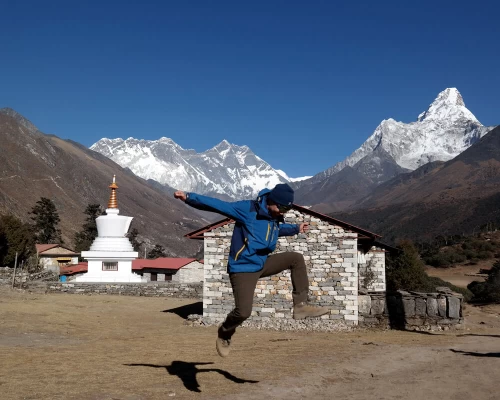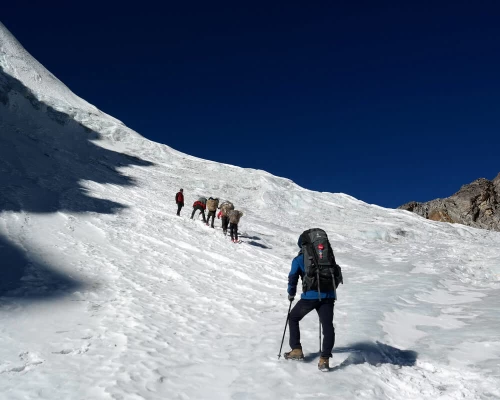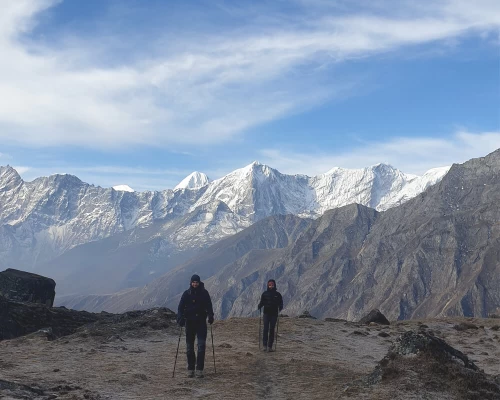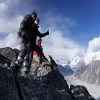The Everest three pass trek will take you to the heights you could never imagine. It is the ultimate trekking program in the Everest region of Nepal packed with both adventure and cultural encounters. On this trek, you will go above 5,000 meters (16,404 ft) from sea level multiple times. Who is this trek for? Individuals with strong fitness and previous high altitude experience can do the three pass trek in Everest.
For nearly three weeks you will be exploring the gems of Nepal, witnessing breathtaking landscapes. Many say the three high passes- Kongma La (5,540 m/18,176 ft), Cho La (5,420 m/17,782 ft), and Renjo La (5,360 m/17,585 ft), are like summiting three peaks, and we as well agree. Nevertheless, the journey is not technically advanced at all.
Join us on 19 days three pass trek in Nepal and embark on a lifetime adventure that will take you to the hidden corners around the tallest mountain in the world. Challenge your limits and make new benchmarks for yourself. The Everest three passes is one of the ultimate treks in the Himalayas.
What are the major attractions during the three pass trek in Nepal?
There is a lot to explore and experience during the 3 pass trek. Below, we have mentioned the top attractions of this trek:
- The thrilling Lukla flight is the first thing you will come across on this trek. The Lukla airport (2,846 m/9,337 ft) is quite famous for its location, altitude, and short runway.
- The adventurous trail winding from lush rhododendron and magnolia forests to terraces and glacier moraines. Cross many suspension bridges on the way and trek on steep, rugged tracks.
- The Namche Bazaar (3,440 m/11,290 ft) is the biggest Sherpa settlement in the Khumbu region. From gear and souvenir shops to restaurants, luxury lodges, cafes, museums, and health clinics, there are many more services than you might have anticipated.
- Side hikes to Everest Hotel View (3,962 m/13,000 ft), Chhukung Ri (5,546 m/18,195 ft), Gokyo Ri (5,357 m/17,575 ft), and Kala Patthar (5,545 m/18,192 ft). You also have the option to go on an excursion to Ama Dablam Base Camp and Island Peak Base Camp. These side hikes help you acclimatize and present gorgeous sunrises and mountain panoramas.
- On this trek, get to see views of five eight-thousander mountains: Everest (8,849 m/29,032 ft), Kanchenjunga (8,586 m/28,169 ft), Makalu (8,463 m/27,766 ft), Lhotse (8,516 m/27,940 ft), and Cho Oyu (8,188 m/26,864 ft). Likewise, the trek offers views of many other peaks like Ama Dablam (6,812 m/22,349 ft), Pumori (7,161 m/23,494 ft), Nuptse (7,861 m/25,791 ft), Thamserku (6,608 m/21,680 ft), Cholatse (6,440 m/21,130 ft), etc.
- The Sherpas and other mountain communities will enrich your journey with their heart-warming welcomes and kind gestures. Interact with the local communities during your overnight stays and get to know their lifestyle.
- Visit some of the oldest monasteries in the Himalayas, like Tengboche (3,860 m/12,660 ft), Pangboche (3,985 /13,074 ft), and Thame (3,800 m/12,467 ft). Likewise, you will come across many stupas, chortens, prayer wheels, and prayer flags on the way. You will be amazed by seeing the cultural richness.
- Reach the lap of the highest mountain in the world, Everest Base Camp (5,364 m/17,598 ft), along the Khumbu Glacier moraine. Get to see the infamous Khumbu Icefall.
- Trek past the biggest glacier in Nepal, Ngozumpa Glacier, while trekking to Gokyo Valley. Here, explore the stunning Gokyo Lakes, which carry religious values too. These beautiful lakes will leave you mesmerized.
- Explore the Nangpa La Valley and the less visited Sherpa village called Marlung.
- While exploring all these places, you will cross the three passes that connect all these places with each other.
Who can do the three pass trek, and what to expect during this trek?
The three pass trek is not for everyone. This is a seriously challenging trek with very demeaning ascents and descents. Not only that, this trek also requires 19 days of commitment. If you have the fitness, mindset, and time, you may consider the three high passes trek. You will trek a minimum of 6 hours a day, and some days can go well above 7 to 8 hours.
You will be trekking on diverse terrain and changing altitudes. As the trek progresses, you will get used to elevation because our three pass trek itinerary is well-designed, keeping acclimatization in point. You will have dinner and breakfast in the same place you spend overnight and lunch on the way. Porters will be ahead of the group, so keep essentials in your daypack.
Three high passes trek: clockwise or anti-clockwise?
Anti-clockwise: Start with Kongma La pass and end with Renjo La pass.
Clockwise: Start with Renjo La pass and end with Kongma La pass.
Our 19 days three-pass trek itinerary follows an anti-clockwise direction. Most of the trekkers do the 3-pass trek in the anti-clockwise direction because it provides a better acclimatization chance. By the time you reach Everest Base Camp (on the 10th day), you will be well-acclimatized.
However, if you follow the clockwise route, you have to climb Renjo La pass (5,360 m/17,585 ft) on the 6th day and spend the night in Gokyo village at 4,750 meters (15,584 ft). It is not only physically very draining, but you will be spending the night at quite a high altitude very quickly.
For a better acclimatization schedule, we recommend doing the Everest three high passes trek in the anti-clockwise direction!
Everest three passes trek cost 2024/2025
The Everest three pass trek cost starts at USD 1650 per person and goes up to USD 5,000 per person as per the services included in the package. The package cost covers major expenses during the trek, however, the participants have to manage the international flight fares, tips, shopping, travel insurance, additional night stay or food/drinks, etc by themselves.
High-demand seasons like spring (March to May) and autumn (September to November) may have slightly higher costs due to favorable weather conditions and popularity. Similarly, during the off-seasons the price of accommodations, meals, and Lukla flights get low, making the overall cost of the package a bit down.
Get the best three pass trek 2024 cost with us!











